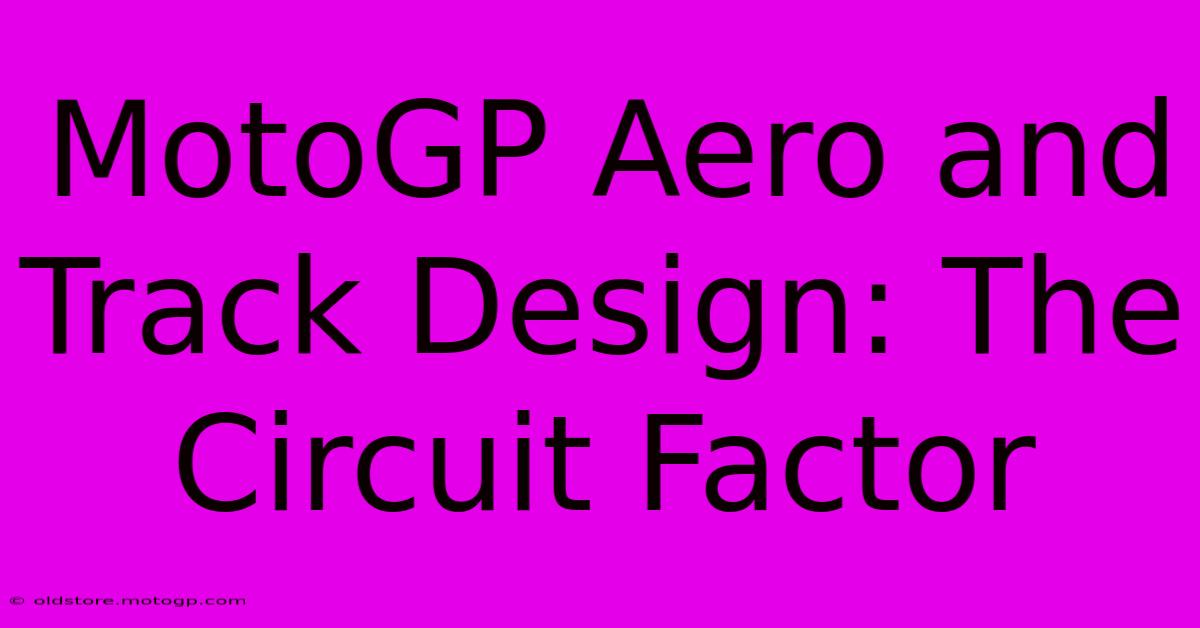MotoGP Aero And Track Design: The Circuit Factor

Table of Contents
MotoGP Aero and Track Design: The Circuit Factor
MotoGP, the pinnacle of motorcycle racing, is a constant battle of speed, skill, and technological innovation. One crucial area where these three elements intertwine is the interplay between aerodynamic packages (aero) and track design. The characteristics of a specific circuit significantly impact the effectiveness of a bike's aero, influencing rider strategies and ultimately the race outcome. This article delves into the complex relationship between MotoGP aero and track design, exploring how the circuit dictates aerodynamic choices and vice-versa.
The Aerodynamic Arms Race
Modern MotoGP bikes are marvels of engineering, boasting sophisticated aerodynamics designed to maximize downforce and minimize drag. Wings, winglets, and other aero devices generate downforce, pressing the bike to the track at high speeds, improving stability and cornering performance. However, the effectiveness of these aero solutions is highly dependent on the specific characteristics of the racetrack.
High-Speed Circuits vs. Tight Turns
High-speed circuits, like Monza or Mugello, demand maximum downforce to maintain stability at incredibly high speeds. These tracks reward aggressive aero packages, allowing riders to carry more speed through long, sweeping corners. Teams will prioritize downforce even if it slightly increases drag, accepting a minor loss of top speed for enhanced cornering stability.
Tight and twisty tracks, conversely, prioritize minimizing drag. Circuits like the Sachsenring or Assen demand agility and rapid changes in direction. Excessive downforce on these tracks can hinder cornering speed, making the bike less nimble and potentially causing instability. Teams might opt for less aggressive aero packages, even sacrificing some downforce to improve acceleration and responsiveness.
Track Layout and Aero Optimization
The specific layout of a track significantly impacts how teams approach aero development and setup.
Corner Radii and Gradient:
- Tight, low-radius corners: Require a balance between downforce and minimal drag. Teams need to find the sweet spot to keep the bike stable without hindering maneuverability.
- Long, high-radius corners: Allow for more aggressive aero configurations. The bike can maintain high speeds and benefit from the increased stability provided by higher downforce.
- Elevation changes: Uphill sections demand more downforce to keep the bike grounded, while downhill sections can require less aggressive settings to prevent excessive downforce from upsetting the balance.
Straight Length and Characteristics:
- Long straights: Favor low-drag configurations to maximize top speed. Teams will often prioritize speed on the straights, even at the cost of some downforce.
- Short straights: Allow for a greater emphasis on downforce, as the impact of increased drag during the shorter straights is less significant.
The Rider's Role: Adaptability is Key
While the bike's aero plays a vital role, the rider's ability to adapt to different track characteristics and aero setups is equally crucial. A skilled rider can manage the bike's behavior, mitigating the potential downsides of an aero package that's not perfectly suited to the circuit. Their feedback is invaluable in the continuous refinement of aero designs and race strategies.
Conclusion: A Continuous Feedback Loop
The relationship between MotoGP aero and track design is a dynamic and complex one. It's a continuous feedback loop where track characteristics influence aero development, and aero developments, in turn, shape racing strategies and outcomes. Teams constantly analyze track data and rider feedback to optimize their aero packages for each circuit. As technology continues to evolve, this interplay between aero and track design will only become more sophisticated and crucial in determining the winners and losers in the electrifying world of MotoGP.

Thank you for visiting our website wich cover about MotoGP Aero And Track Design: The Circuit Factor. We hope the information provided has been useful to you. Feel free to contact us if you have any questions or need further assistance. See you next time and dont miss to bookmark.
Featured Posts
-
Us Gp Sprint The Excitement Is Palpable
Feb 19, 2025
-
Ride Like A Pro Moto Gp Motorcycle For Sale
Feb 19, 2025
-
Cut The Cord Moto Gp Live Stream Free Online Today
Feb 19, 2025
-
Push The Pedal To The Metal Cota Open Track Days
Feb 19, 2025
-
Moto2 Specs What The Pros Know
Feb 19, 2025
